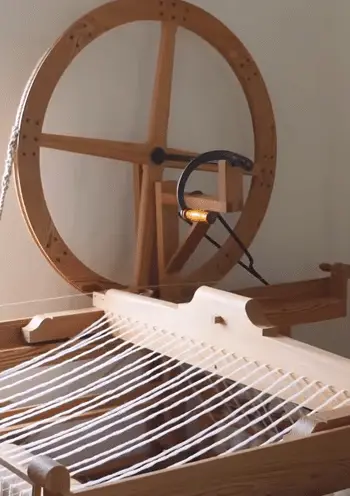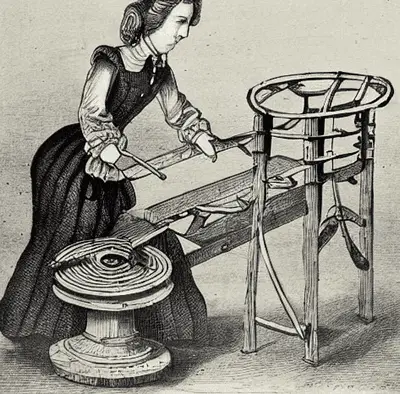The spinning jenny is a device that revolutionized the textile industry by greatly increasing the efficiency of yarn production. This innovative machine allowed multiple spools of yarn to be spun simultaneously, vastly increasing the productivity of yarn production. But who invented the spinning jenny?
The spinning jenny was invented by a man named James Hargreaves, a weaver from Lancashire, England. The spinning jenny was a major advancement in textile production, as it allowed for the creation of multiple threads at once, significantly increasing the efficiency of the spinning process.
Continue reading to learn more about James Hargreaves and the spinning jenny, including the challenges he faced in getting his invention off the ground and the impact it had on the industry and society as a whole.
Who Invented the Spinning Jenny During the Industrial Revolution?

The spinning jenny, invented during the industrial revolution, is a device that transformed the textile industry by greatly increasing the efficiency of yarn production.
James Hargreaves is a man Who invented the spinning jenny during the industrial revolution.
Hargreaves, who was known to be a skilled mechanic, was able to combine his expertise in weaving and carpentry to develop this revolutionary machine.
Before the invention of the spinning jenny, yarn production was a labor-intensive task that could only be performed by skilled hand spinners.
The spinning jenny, however, made yarn production more efficient and cost-effective, allowing for the mass production of yarn.
The spinning jenny was a game changer for the textile industry, enabling manufacturers to produce yarn faster and at a lower cost.
The invention of the spinning jenny also led to the development of other spinning machines, such as the spinning mule and the power loom, which further increased the efficiency and productivity of the textile industry.
James Hargreaves’s invention of the spinning jenny is considered one of the key inventions of the industrial revolution that contributed to the modernization of textile production.
When Was the Spinning Jenny Invented?
The spinning jenny is a device that was invented to revolutionize the textile industry during the industrial revolution.
The exact date of the invention of the spinning jenny is not known, but it is believed to have been invented around 1764-1765.
James Hargreaves, a weaver, and carpenter from Blackburn, Lancashire, England, is credited with inventing the spinning jenny.
According to historical records, Hargreaves was said to have come up with the idea for the spinning jenny while observing his daughter spinning yarn with a spinning wheel.
He noticed that she could spin only one thread at a time, and he thought that there must be a way to spin multiple threads at once.
By the end of the 18th century, when was the spinning jenny invented, it had spread throughout Great Britain and Europe, and it was also exported to other countries, including the United States.
Hargreaves is considered the inventor of the spinning jenny, while the machine was quickly developed and improved by other inventors as well in the years following its invention.
It’s a pivotal invention of the industrial revolution that contributed to the modernization of textile production.
It improved the standard of living by making textiles cheaper and more available to the general public.
What is the Spinning Jenny and How Did it Work?
How to tell what is the spinning jenny and how it work?
A spinning jenny is a machine that is designed to spin multiple threads at the same time.
It works by using a series of spinning wheels, each of which is connected to a single spindle.
The spindle is connected to a rotating wheel, which is powered by either a hand crank or a foot pedal.
The operator feeds the fibers into the spinning wheels, and the machine then spins the fibers into thread.
The spinning jenny also allowed for the production of a greater variety of thread.
The machine could be adjusted to produce a thread of different thicknesses and qualities, which meant that it could be used to produce thread for a wide range of textiles.
Although the spinning jenny was a major innovation in the textile industry, it was not without its drawbacks.
The machine was complex and difficult to operate, and it required skilled labor to run effectively.
Additionally, the spinning jenny could only spin one type of fiber at a time, which limited its usefulness.
What Did the Spinning Jenny Do?
The spinning jenny is designed to spin several threads at once by connecting a succession of spinning wheels to a single spindle.
The fibers would be fed into the spinning wheels by the operator, and the machine would spin the fibers into thread.
By spinning many threads at the same time and creating lines of various thicknesses and quality, the spinning jenny increased productivity and efficiency in textile production.
It was the forerunner of later spinning devices such as the water frame and power loom.
Spinning Jenny Inventor: James Hargreaves

James Hargreaves was an English weaver and inventor who is best known for inventing the spinning jenny.
He was born in Oswaldtwistle, Lancashire, England in 1720 and worked as a weaver in the local cotton mills.
Hargreaves was dissatisfied with the slow and labor-intensive process of spinning thread by hand, and he began experimenting with ways to improve the efficiency of the process.
His invention, the spinning jenny, was a machine that was designed to spin multiple threads at the same time, allowing for a significant increase in productivity and efficiency.
The spinning jenny was first patented in 1770 and became widely adopted in the textile industry.
It allowed the production of a greater variety of thread and was capable of spinning one type of fiber at a time, making it useful for a wide range of textiles.
Hargreaves made a profit from the invention and established a factory to manufacture spinning jennies in Blackburn, Lancashire.
Despite the challenges, the spinning jenny was an important step forward in the development of the textile industry and Hargreaves became a respected figure in the industry.
His invention paved the way for the development of more advanced spinning machines, such as the water frame and the power loom, which further increased the efficiency and productivity of textile production.
Spinning Jenny Facts
Here are some spinning jenny facts that might interest you:
- The spinning jenny was invented by James Hargreaves in 1764.
- It was one of the first spinning machines developed during the Industrial Revolution and was a significant improvement over hand spinning.
- The spinning jenny was designed to spin multiple threads at the same time, which increased productivity and efficiency in textile production.
- It used a series of spinning wheels, each connected to a single spindle, that was powered by a hand crank or foot pedal.
- The machine could be adjusted to produce a thread of different thicknesses and qualities, making it useful for a wide range of textiles.
- The spinning jenny was patented in 1770 and became widely adopted in the textile industry.
- However, it was complex and difficult to operate and required skilled labor to run effectively.
- The spinning jenny was not well received by traditional weavers, who saw it as a threat to their livelihoods and destroyed many of the machines in the early years of production.
- The spinning jenny was a precursor for later spinning machines such as water frame and power loom, which increased productivity even more.
Spinning Jenny Impact
One of the most notable impacts of the spinning jenny was that it greatly reduced the cost of producing textiles.
The machine allowed for the mass production of thread, which resulted in a decrease in the price of textiles.
This made textiles more affordable for the general population and contributed to the growth of the textile industry.
It also allowed for the production of a greater variety of thread, with different thicknesses and qualities, making it useful for a wide range of textiles.
This was important to the expansion of the textile industry and the development of new forms of textile production.
The spinning jenny was also a precursor for later spinning machines such as the water frame and power loom, which increased productivity even more.
Traditional weavers viewed the spinning jenny as a danger to their livelihoods and destroyed many of the machines in the early years of manufacture.
Why Was the Spinning Jenny Important?
The spinning jenny was a crucial invention in the history of textiles, as it greatly increased the efficiency of the spinning process and allowed for the mass production of yarn.
One of the key reasons for its importance was that it allowed for the spinning of multiple threads at once, as opposed to the traditional method of spinning one thread at a time on a spinning wheel.
This increased the productivity of spinners, enabling them to produce more yarn in a shorter amount of time.
Additionally, the spinning jenny was relatively inexpensive and easy to operate, making it accessible to a wider range of people.
This allowed for the growth of cottage industries, in which individuals could spin yarn in their own homes, rather than having to work in a centralized factory.
This provided more opportunities for work and allowed for the spread of textile production beyond the traditional urban centers.
FAQ
These are some of the most frequently asked questions about who invented the spinning jenny.
Is the spinning jenny still used today?
The spinning jenny is not widely used today in the manufacturing of textiles. The spinning jenny was largely replaced by more advanced and efficient machinery.
Why was it called spinning jenny?
It was named after its inventor, James Hargreaves. He named it after his daughter, Jenny, in recognition of her help in developing and testing the machine.
Why was the spinning jenny destroyed?
A spinning jenny isn’t destroyed, but rather it is outdated and has been replaced by more advanced and efficient machinery in the textile industry.
Who invented spinning jenny Class 9?
It was invented by James Hargreaves, a weaver, and spinner from Lancashire, England in the late 1760s
How was the spinning jenny discovered?
The spinning jenny was invented through a combination of experimentation and observation. According to accounts of his life, Hargreaves was a skilled weaver and spinner. To improve the process, he began experimenting with ways to spin multiple threads at once.
Conclusion
In the end, the spinning jenny was a revolutionary invention that transformed the textile industry during the industrial revolution.
The spinning jenny played a crucial role in the economic development of many countries and particularly helped the growth of the textile industry in Great Britain.
I hope you enjoyed learning about the history and impact of the spinning jenny. I would love to hear your thoughts and opinions on the topic, so please feel free to leave a comment below.
Take a look at the most famous inventions:

